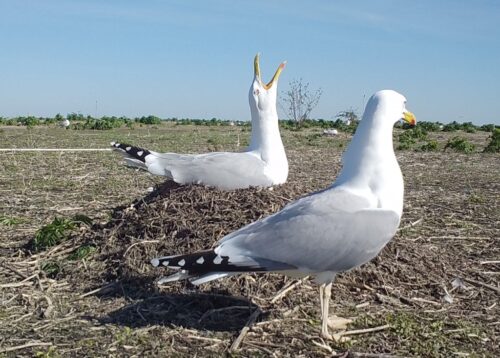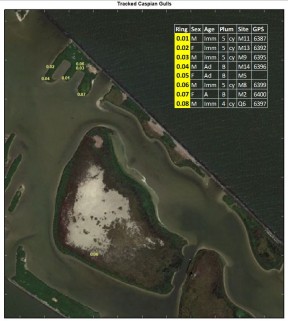Species: Caspian Gull
De Kreupel (52°47.8’N, 05°13.6’E) is an island, created exclusively for birds. The island that is 70 hectares in size is located in the IJsselmeer, 4.5 km from Andijk. It is actually an archipelago of smaller and larger islands, shallows, channels and dams (Staatsbosbeheer 2023). In 2023 we will start GPS-tracking adult, Caspian Gulls Larus cachinnans that breed at De Kreupel, which will be a new collaboration project between the University of Amsterdam and Royal NIOZ, now with Staatsbosbeheer. The project is also a demonstration for ARISE. The Caspian Gull is a colonizing species on the island, that has been found prospecting and breeding there since around 2014. This study will run in parallel to a Herring Gull Larus argentatus tracking study at Texel and studies on Lesser Black-backed Gulls Larus fuscus at IJmuiden and Texel, with scientific emphasis on the foraging ecology (feeding habitats), post-breeding dispersal, migratory behaviour and wintering destinations.

Breeding population
The Caspian Gull has recently spread from Ukraine (northern coast of the Black Sea, River Dnipro) to Poland, Czech Republic, Germany and into The Netherlands. The first breeding bird in The Netherlands was documented as recently as in 2012, when a 5thcy male partner formed a mixed pair with a female Herring Gull, at Nederrijn near Amerongen. The couple raised a single, hybrid chick from a clutch of three eggs (Gelderblom 2012). In 2014, a more or less resident adult pair of Caspian Gulls was seen at De Kreupel (IJsselmeer), and in the next four years more and more breeding attempts were documented at De Kreupel and on breakwaters near Lelystad. In 2019, at least 12 pure pairs of Caspian Gulls and a mixed pair bred near Lelystad, while four pairs were found at De Kreupel (Kelder et al. 2023). In 2020, the population had apparently exploded, when 42 breeding pairs were detected on these two locations only (15 at De Kreupel, 27 near Lelystad). Some of the breeding birds were ringed as chicks in Poland (Babice en Paczków) and in the eastern half of Duitsland (Gräbendorfer lake).
What is going on? The dispersal and spread of Caspian gulls from their original breeding grounds to the east, with the main destinations (thus far) being within the Czech Republic, Hungary, Poland, Germany, the Netherlands, and Belgium, has triggered a general interest, first simply because a ‘rarity’ triggers attention and interest by keen birders. It is, however, not the first time that a (large) gull species has colonized new areas, thereby massively increasing its breeding range, to even become a common breeding species in areas where it had been virtually unknown, even as a vagrant, in earlier years (Spaans 1998, Camphuysen 2013).
Foraging grounds
The first telemetry recordings (in Central Europe) indicated the importance of notably fresh waterbodies as an important foraging environment (rivers, lakes, but also coastal areas), followed by landfill sites, mineral extraction sites, industrial or commercial units (including roofs of buildings), arable or other agricultural land (Litwiniak et al. 2021). Aquacultural fish ponds and large areas of managed arable land represented important resources, but why such a newcomer is able to exploit areas like this, while highly similar species such as Herring Gulls and Lesser Black-backed Gulls suffer from declining resources, remains unclear (Camphuysen et al. 2023). This tracking study is primarily meant to explore and understand the foraging range of the newly established species within and around the IJsselmeer, and to see if indeed an empty niche has been occupied by the newcomer, and if so where, or if this spread comes somehow at the expense of the other large white-headed gulls with established, but currently declining breeding populations.
Aim of this study
The aim of this study is to quantify the foraging movements, time budgets and habitat preferences of these birds. Using this information, we can conduct comparative analysis of these aspects between individuals, years, genders, breeding phases and migration, but also between similar species, such as the Herring Gull and the Lesser Black-backed Gull. We will also aim to study the energetic cost of foraging movements by incorporating information on flight strategy selection. In the future we may be able to link these characteristics to life history traits and fitness.

In the breeding season of 2023, the first adult breeding birds will be colour-ringed and tagged for the first time. Colour rings that will be used are yellow, numbered rings (shown below). Sightings and hopefully also photographs of the birds are warmly welcomed, so that we can monitor the well-being of the tagged individuals, but also plumage developments and various other aspects. Reports of birds seen can be sent by (preferably) email to at the Royal Institute for Sea Research (NIOZ) à kees.camphuysen@nioz.nl, and receive a life-history of the bird with all details known to that date will promptly be provided. Further details regarding the ringing programme(s) at https://cr-birding.org/node/6409
All birds with such rings will carry advanced GPS trackers developed by UvA-BiTS, and their most recent movements can be followed via the interactive maps.

Contact persons, funders and participants
Kees Camphuysen kees.camphuysen@nioz.nl Koninklijk Nederlands Instituut voor Onderzoek der Zee / Royal Netherlands Institute for Sea Research (NIOZ)
Judy Shamoun-Baranes shamoun@uva.nl University of Amsterdam Institute for Biodiversity and Ecosystem Dynamics / Instituut voor Biodiversiteit en Ecosysteem Dynamica (IBED)
References
- Camphuysen C.J. 2013. A historical ecology of two closely related gull species (Laridae): multiple adaptations to a man-made environment. Ph.D.-thesis, Univ. Groningen.
- http://dissertations.ub.rug.nl/faculties/science/2013/c.j.camphuijsen/.
- Camphuysen C.J., S.C. van Donk, J. Shamoun-Baranes & R. Kentie 2023. The annual cycle, breeding biology and feeding ecology of the Lesser Black-backed Gull Larus fuscus. Ardea 111 doi:10.5253/arde.2023.a7.
- Gelderblom P.G. 2012. Eerste broedgeval Pontische Meeuw voor Nederland, maart-augustus 2012.
- http://www.birdingwageningen.blogspot.nl.
- Kelder L., R-J. Buijs, A. de Jong & M. Muusse 2023. Onderzoek aan broedende Pontische Meeuwen (Larus cachinnans) in het IJsselmeergebied 2022.
- www.gull-research.org/cachinnans/01holland01.html
- Litwiniak K., M. Przymencki & A. de Jong 2021. Breeding-range expansion of the Caspian Gull in Europe. Brit. Birds 114: 331-340.
- Skórka P., Wójcik J.D. & Martyka R. 2005. Colonization and population growth of Yellow-legged Gull Larus cachinnans in southeastern Poland: causes and influence on native species. Ibis 147: 471-482.
Spaans A.L. 1998. Booming gulls in the Low Countries during the 20th century. Sula 12(4): 121-126. - https://natuurtijdschriften.nl/pub/553991
- Staatsbosbeheer (Accessed 2023) Over West-Friesland – Vogeleiland De Kreupel.
- https://www.staatsbosbeheer.nl/uit-in-de-natuur/locaties/west-friesland/over-west-friesland
